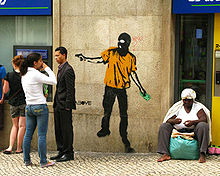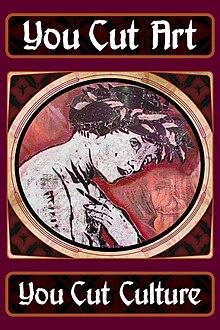Artivism
This article is written like a personal reflection, personal essay, or argumentative essay that states a Wikipedia editor's personal feelings or presents an original argument about a topic. (August 2012) |

Artivism is a portmanteau word combining "art" and "activism".
Artivism developed in recent years while the antiwar and anti-globalization protests emerged and proliferated. In many cases artivists attempt to push political agendas by the means of art, but a focus on raising social, environmental and technical awareness is also common. Besides using traditional mediums like film and music to raise awareness or push for change, an artivist can also be involved in culture jamming, subvertising, street art, spoken word, protesting and activism.[1][2][3]
Artivist Eve Ensler has stated:
... This passion has all the ingredients of activism, but is charged with the wild creations of art. Artivism — where edges are pushed, imagination is freed, and a new language emerges altogether." Bruce Lyons has written: "... artivism ... promotes the essential understanding that ... [humans] ... can, through courageous creative expression, experience the unifying power of love when courage harnesses itself to the task of art + social responsibility.[1][2][3]



In some cases, Paris in 2003 for instance, artivists were arrested for acts of political art that verged on property destruction. [citation needed] A typical short-term goal of artivists is to reclaim public space, especially by subvertising or destroying ads in urban areas or on city transportation systems. Nevertheless artivists engage in different media like utilizing the Internet not only for actions which could be described as hacktivism.
By 2008 the term made its way into academic writing, with Chela Sandoval and Guisela Latorre published a piece on Chicano/a artivism and M. K. Asante used the term in reference to Black artists.[4]
There is a chapter on Artivism in It's Bigger Than Hip Hop by M. K. Asante. Asante writes of the artivist:
The artivist (artist +activist) uses her artistic talents to fight and struggle against injustice and oppression—by any medium necessary. The artivist merges commitment to freedom and justice with the pen, the lens, the brush, the voice, the body, and the imagination. The artivist knows that to make an observation is to have an obligation.
Artivists
Collectives & Organizations
See also
References
- ^ a b Politics, Power and Passion, The New York Times, December 2, 2011. Please see the fifth segment by Eve Ensler.
- ^ a b Jeanmarie Simpson -- Artivist in the Modern Landscape (Part 1), Dylan Brody, The Huffington Post, 2011.10.03
- ^ a b Jeanmarie Simpson -- Artivist in the Modern Landscape (Part 2), Dylan Brody, The Huffington Post, 2011.10.05
- ^ Chela Sandoval and Guisela Latorre, ""Chicana/o Artivism: Judy Baca's Digital Work with Youth of Color," in Learning Race and Ethnicity, (MIT Press, 2007) ; M.K. Asante, Jr. It's Bigger Than Hip Hop (book) (St. Martin's Press, 2009).
